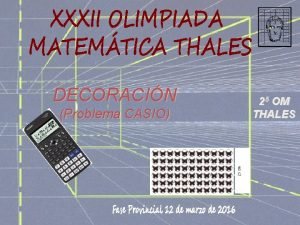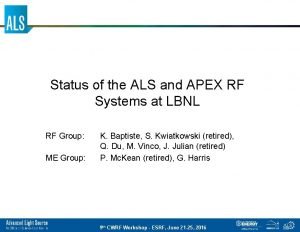www thalesgroup com Thales Klystrons for Linacs High







- Slides: 7

www. thalesgroup. com Thales Klystrons for Linacs High gradient Day 31 January 2013 Philippe THOUVENIN Thales Klystrons for linacs - High Gradient Day - 31 January 2013

Current R&D Activities on Klystrons at Thales ED 2 / R&D at Thales ED is currently focused on long pulse UHF klystrons £TH 2179: 352 MHz 2. 8 MW 1. 3 ms First tube installed at CERN (Linac 4) £TH 2181: 325 MHz 3. 1 MW 0. 25 ms Prototype in 2013 £TH 2182: 704 MHz 1. 5 MW 2 ms Efficiency target: 65%. Prototype in 2013 TH 2182 : 704 MHz 108 k. V 22 A Ps = 1. 6 MW @ 704 MHz Efficiency > 65%

Short Pulse Klystrons (< 10 µs) 3 / S band klystrons: u Strong heritage on 45 MW 20 k. W family (2856 MHz and 2998 MHz) u Demonstrated life time > 40000 hours u Production > 25 klystrons / year u TH 2100 L : 60 MW 1. 5µs 100 Hz operating at 350 k. V 408 A installed at PSI. New Products in S band Increase of peak power up to 80 MW 4µs 120 Hz is achievable with conventional klystron technology. £ Development can be launched only for significant quantities. £ Thales Klystrons for linacs - High Gradient Day - 31 January 2013

4 / Short Pulse Klystrons (< 10 µs) in C or X band C band : 5712 MHz 50 MW 2. 5µs 100 Hz Klys. Top Fo=5. 7 GHz Pe=120 W Ps=50. 5 MW n=45% u Thales has an interest in developing such klystron, with the support of european labs and is open for collaboration. u Design study is in progress. X band : 11994 MHz 5 MW 5 k. W Thales Klystrons for linacs - High Gradient Day - 31 January 2013 u Thales has performed a detailed design study of an X band klystron. u The S band medical klystron technology is a strong basis for this development. u Market size and perspectives to be confirmed.

5 / Long Pulse Klystrons : L band Multi Beam Klystron TH 1802: 1300 MHz 10 MWp 150 k. Wa Efficiency > 63% u 22 tubes under production for EXFEL (DESY) u Industrial experience to produce high power MBKs at 1 unit /month u RF Windows under air (No SF 6) u Very stable operation u Good baseline to address CLIC needs in L band Thales Klystrons for linacs - High Gradient Day - 31 January 2013

Efficiency increase on L band Multi Beam Klystron 6 / It takes 10 years to develop and master a new technology. u Thales is building on the MBK heritage to study a 1 GHz RF source for the CLIC drive beam. Efficiency target η = 70%. u Increase of beamlets Nr (up to 20) decrease of individual beam perveance (~ 0. 2 µP) high interaction efficiency (η = 78 - 0. 16 x P) u Theoretical Feasibility already demonstrated u Design studies to be pursued on beams optics, cavity geometry and interaction mode and RF stability. u Collaboration frame: Hypernet Thales Klystrons for linacs - High Gradient Day - 31 January 2013

Conclusions 7 / u Thales ED is involved on the long term in the scientific market and is willing to work with european labs to prepare the future needs. u We think that new technologies have to be prepared well in advance (5 to 10 years) and this needs to be well coordinated and supported. u Collaboration with labs is very important at several steps: u £ Understanding of trends on RF needs to oriente properly our developments. £ Work share and technical exchanges in the design phase. £ In some cases, use of labs facilities to test the new prototypes. New accelerator projects like CLIC will require efficient, reliable and affordable RF sources, due to the high number of units involved. £ the MBK technology is a promising solution for CLIC L band requirements and can benefit from the experience of E-XFEL program. £ Thales ED intends to explore new MBK concepts in collaboration with CERN to achieve more than 70% efficiency with good reliability and lifetime. Thales Klystrons for linacs - High Gradient Day - 31 January 2013












